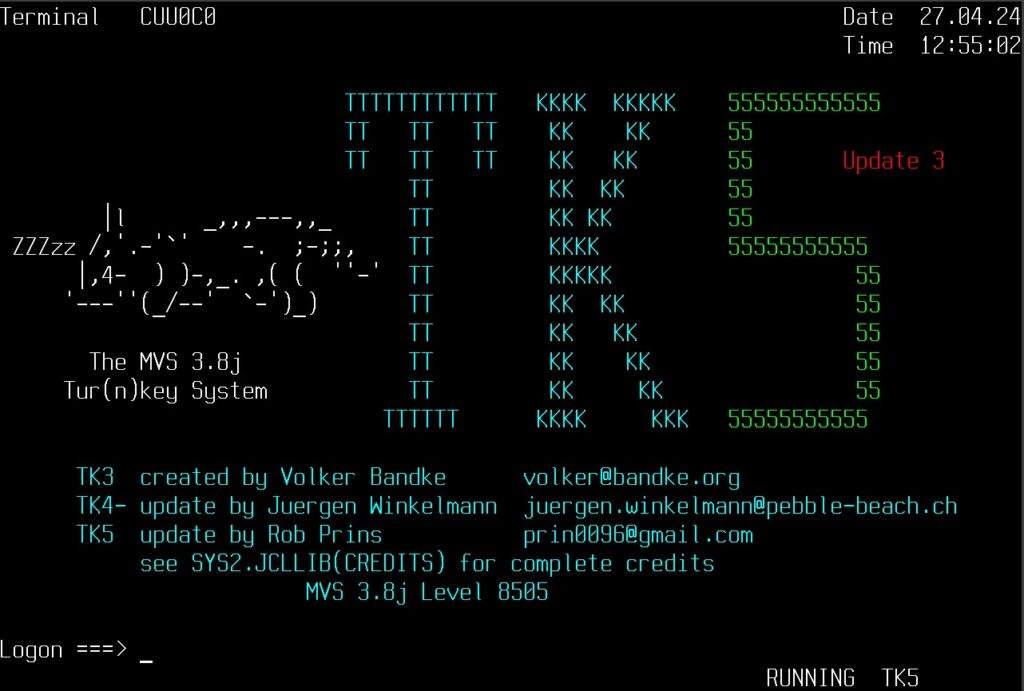
One of our most popular posts ever was titled “Run a $8 Million Mainframe at Home for FREE!”
It struck a chord with a lot of hobbyists, because it’s really what our site is all about: take a cheap VPS or home VM and run enterprise-grade software on it, for nearly free.
The software in question is the legendary MVS operating system from IBM. After ENIAC and the early purpose-built systems of the late 40s and 50s, IBM started to evolve a general system that had a resident operating system, and this became OS/360, one of the most famous IT projects of all time. Prior to OS/360, most computing systems were “run a job through and then reset everything”. With OS/360, there was an online, resident operating system that was always available to handle requests.
The system’s resources could be shared and jobs prioritized. The hardware was also modular, in the sense that one site might have three card readers, two printers, and a tape drive, while another might have hard disks (called DASD for Direct Attached Storage Device) and more CPUs, depending on user needs.
MVS 3.8j was the end of that cycle of OS development, and it was released in 1981. Subsequently, IBM went on to create z/OS, which powers all of today’s mainframes, but it is still MVS-like under the hood.
Your Free Mainframe
The cool thing about MVS 3.8j is that IBM released it for free, so anyone can fire up their own mainframe. This would have cost $8 million in the early 70s! Under the hood, you’re running on the Hercules emulator, which launches an MVS image for you to use and simulates IBM hardware, including printers, card readers, disks, and other peripherals.
Of course, it’s 24-bit computing, which puts a hard limit at 16MB of memory. Before you scoff, keep in mind that Linux once ran quite comfortably in 16MB of RAM. Also, 16MB of RAM in the 70s was massive. Finally, the mainframe OS is designed to work well with this hardware. If you’re trying to run Bank of America on it, no, it won’t work, but for hobbyist systems, you can get very far.
If you doubt me, check out the guy who’s running his business on an emulated 1970s mainframe!
Getting oriented on a new operating system – particularly one as user-unfriendly as 1970s mainframes – is no easy tasks. Most enthusiasts are “big iron” people in their day jobs, just as a lot of Linux enthusiasts run systems at work.
To make things easier, the community coalesced around “turnkey” setups, the most famous of which were TK3 and TK4-. All you need do is explode its tarball, type “mvs”, and then connect to your new mainframe.
And Now TK5 is Here!
After our original TK4- article, I got busy on other projects and didn’t get back to playing with the mainframe. Recently, I learned that TK5 is now out, and it’s packed with new features.
First, the maintainer has carefully separated out the OS disks and your local disks. Previously, things were mixed, which made upgrades painful or impossible. Now you can smartly update your OS while leaving your local data sets, etc. untouched. This took a lot of patient and careful work by a mainframe guru, but once done, the environment is perfectly prepared for future maintenance and updates.
Second, the new kit is brimming with documentation. This has been the community’s weak spot. The Moshix YouTube channel (highly recommended) has filled in a lot of tutorials, but having solid “how do I…” documentation is a game-changer. Instead of hunting down expired pages on archive.org to find some scanned 1970s PDF, the lion’s share of what you might need is in a handy ‘doc’ directory.
And finally, tons of new software has been added!
- Many new language packs. Choose from COBOL, Fortran, ALGOL, PL/I, BREXX, and more!
- The whole Intercomm suite is now installed. Intercomm offers a CICS analogue. “Kicks” is an application layer on the mainframe.
- Many useful utilities, such as ARCHIVER and an HTTPD server.
Let’s Play!
To get started:
- Download TK5 and follow the instructions
- You’ll want a TN3270 client. I use zoc8 for Mac.
- You should take a look at Moshix’s YouTube channel for a lot of awesome tutorials























Leave a Reply